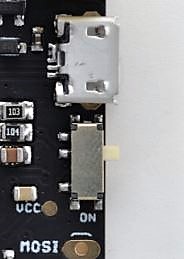Frequently asked questions
- How do I turn on the device?

Firstly, connect the battery to the Sensything board, then switch on the board.
| Question | Solution |
|---|---|
| * Which microcontroller is used? | - The microcontroller used is ESP-PICO-D4 SIP with 4 MB Flash. |
| * Name of the ADC? | - Texas Instruments ADS1220 24-bit Sigma-Delta |
| * Is the sensor data accurate? | With an inbuilt ADC,ADS1220 ensures 24-bit resolution for sensor data. |
| How do I make the Analog connections? | A1 - Channel 1 |
| A2 - Channel 2 | |
| A3 - Channel 3 | |
| A4 - Channel 4 | |
| 3V3 - Supply - Board which supports 3.3V | |
| GND - Ground | |
| * What is the input range? | - The input range is ± 2.048 V to ± 0.016 V (adjustable gain) |
| * What is the Sampling rate for Analog? | - The sampling rate is 20 samples/second (SPS) to 2000 SPS. |
| * What are the current sources? | - There is an On-board excitation current sources adjustable from 10 uA to 1500 uA. |
| * How many I/O pins are there? | - There are 4 general-purpose I/O pins. |
| * How can I determine the BLE communication? | - Once connected through the BLE, the RGB LED will turn OFF. |
| - When it is disconnected then the RGB LED turns ON. | |
| * What is the digital supply voltage? | - It is 3.3V |
| * What are the board dimensions? | - 47x57 mm (length, width), 5 mm height (board only), 12 mm height (with included battery stacked) |
| * Can i use the Qwiic option for connecting sensors? | - There are two Sparkfun Qwiic-compatible I2C ports on board. |
| * What is the range of wireless frequency? | - There is a 2.4 GHz radio with on-board PCB antenna. |
| * What is the voltage reference? | - Built-in 2.048 V voltage reference with 5 ppm/°C drift. |
| * Any inbuilt sensor? | - There is an built-in temperature sensor with 0.5°C accuracy. |
| * What is the power source? | - There is a Li-ion battery (3.7 V, 1000 mAH) as power source.This would be applicable to those who ordered the basic kits. |
| * How do I charge the battery? | - There is an On-board USB battery charger.Ensure that the battery is plugged to the board and then connect the USB cable. You can use a 5v power adapter as the power source. |
